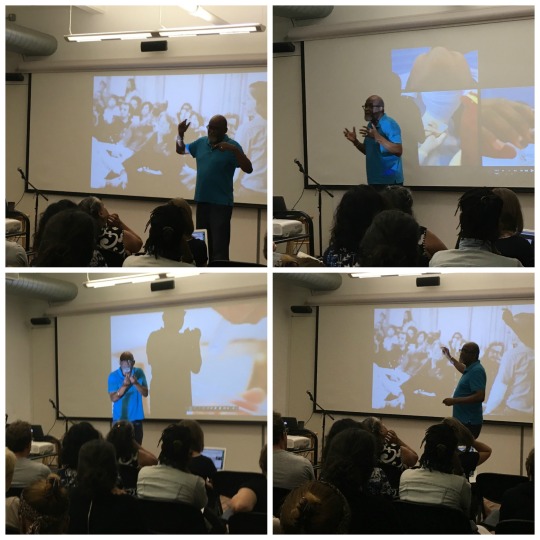Recap | Structuring Movies presented by Sam Pollard
“Editing is like sculpting. All the material is like clay, unformed clay, and my job is to make it into a story and give it shape, form, and a story arc.” – Sam Pollard
Filmmakers: once you’ve developed an idea for a documentary film, shot it on your vintage 16mm or digital camera, and gathered a few archival clips, how do you begin to translate the material into a visually compelling story? Sam Pollard, an award-winning documentary editor, director, and producer, recently visited NYFA to screen sample clips from his edited and directed films including Venus and Serena, When the Levees Broke: A Requiem in Four Acts, and ACORN and the Firestorm and to share his perspective on the essential elements to consider when building a dynamic and gripping story arc.
Below, we’ve summed up some of the key insights Pollard has gained from more than three decades of bringing films to fruition.
In the Field and Gathering Material
Before heading out to film, brainstorm and consider the kind of material you want to capture and assemble the structural concept. For instance, in When the Levees Broke, Spike Lee’s first step was to hire an archivist who skimmed through news articles related to Hurricane Katrina, highlighted names of individuals who commented, and conducted pre-interviews. The archivist also found relevant archival footage and photos. The interviews, archival material, and stills comprised the structural concept and laid the creative foundation for the film.
Documentary films are generally not scripted; however, with documentaries, transcripts become your script. Transcribe all interviews and raw footage captured during filmmaking as this will help during the next phase: the editing room.

In the Editing Room
With raw footage and material in hand, the filmmaker can mold the footage and transform it into a story. Documentary films, says Pollard, are not created in the field per se, but in the editing room. It takes just a bit of creativity, imagination, and technical skill to shape footage into the film you envision.
One of the first and biggest challenges when creating a documentary film is dictating its structure. There is no predetermined narrative – there is simply vérité footage and clips. The filmmaker should ask the fundamental question of “What is my beginning, middle, and end?” and begin editing from that starting point. The easiest documentary to make is a biography since someone’s life is easily translatable into a film’s beginning, middle, and end; the hardest is the social issue documentary; a beginning, middle, and especially the end in these cases are not explicitly evident.
Although visuals are important, a key skill is to listen. Listen (and read your transcripts) to see what the subjects have said, and use this content to direct the transitions and allow the story to unfold. Moreover, find footage that illustrates the subjects’ conversations and pair them together.
You may have a lot of footage, so remember it is necessary to cut out scenes and to ask the question “What is the point of the scene?” to pinpoint essential moments. Moreover, make sure to look for aspects that heighten the dynamic, such as conflict and tension, in order to avoid predictable “lollipop moments.”
All footage is malleable. Never be afraid to move your work around or to do something else with footage you initially planned on using in another way. In most cases, the first cut is not the right one, so keep working and re-arranging to get the story arc you want. A helpful organizing tool is to create a stack of 3×4 cards and write down every scene, place them all on a big bulletin board, and shuffle them around.
Lastly, remember that creativity is also a tool. In Venus and Serena, some of the footage that the filmmakers had access to was shot on an iPhone. In order to maintain a consistent look, Pollard decided to split the screen into three repeating images- a decision that was both practical and aesthetically compelling.
Sam Pollard is an accomplished feature film and television video editor and documentary producer/director whose work spans almost thirty years and includes dozens of well known and award-winning films.
His first assignment as a documentary producer came in 1989 for Henry Hampton’s Blackside production Eyes On The Prize II: America at the Racial Crossroads. Over the next twenty years, Pollard edited a number of Spike Lee’s films: Mo’ Better Blues, Jungle Fever, Girl 6, Clockers, and Bamboozled, and co-produced Spike Lee Presents: Mike Tyson, for which he received an Emmy, 4 Little Girls, which was nominated for an Academy Award, and When The Levees Broke: A Requiem in Four Acts, winner of a Peabody Award and three Emmy Awards. He also co-produced and supervised the edit on If God Is Willing And da Creek Don’t Rise.
Since 2012, Pollard has been a producer/director on Slavery by Another Name, and American Masters—August Wilson: The Ground On Which I Stand. The Talk: Race in America, created for PBS and CPB, aired in 2017, and Two Trains Runnin’, a feature length documentary, will open in theaters in August 2017.
– Priscilla Son, Program Assistant, Fiscal Sponsorship & Finance
This event was presented by NYFA Learning, which offers professional development for artists and arts administrators, and by NYFA Fiscal Sponsorship. NYFA Fiscal Sponsorship’s next quarterly no-fee application deadline is September 30.
Sign up for NYFA’s free bi-weekly newsletter to receive updates on future programs, and check out NYFA’s Business of Art Directory to read more articles on this topic and others.
Images, from top to bottom: photo credit: Mirielle Clifford for NYFA; Collage photo credit: Madeleine Cutrona for NYFA





